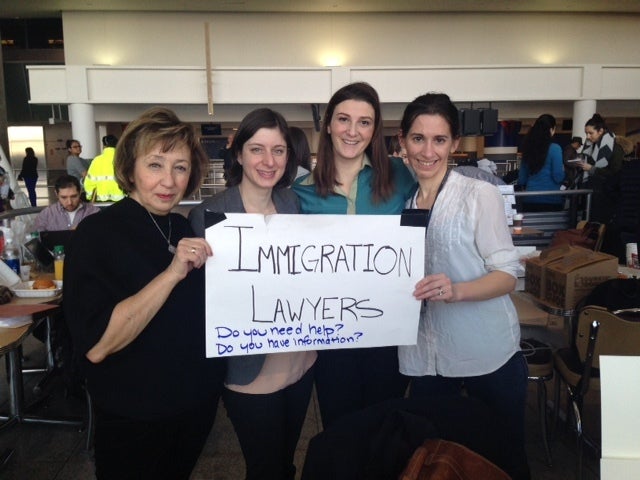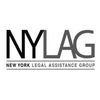By Grace Kao, Immigrant Justice Corps Fellow/Staff Attorney, New York Legal Assistance Group

When President Trump’s Executive Order (EO), Protecting the Nation from Foreign Terrorist Entry, was signed late on Friday, January 27, it was still unclear to many in the legal community how quickly federal agencies would begin implementing the order. Initially, a lot of people believed it could take months for Immigration and Customs Enforcement (ICE) and Customs and Border Protection (CBP) before the order was implemented. However, by Friday night, refugees and other arriving noncitizens flying into airports were stopped and detained. On Saturday morning, immigration advocates all over the country woke up to the news that two Iraqi refugees had been detained at John F. Kennedy International Airport.
On Saturday evening, I went down to JFK with a friend, a criminal defense attorney. We had no idea how we could be helpful, but we knew we had to at least try. We arrived close to 8:30 pm, just in time for news to break that Judge Ann Donnelly in the Eastern District of New York had granted a temporary stay, ordering that refugees, visa holders, lawful permanent residents, and others held at airports could not be sent back to their home countries. Despite the good news, my friend and I knew that there were still people being detained, and wanted to help. The scene at JFK was chaos – when we tried to walk toward the area where the attorneys had set up camp, we were physically blocked and directed outside by New York Port Authority officers. We tried unsuccessfully to reenter the terminal in various ways, wielding our attorney business cards like entry tickets, but after an hour of being shuttled outside to join the general protest, we left for the night.
We returned the next day to find the scene was only slightly less chaotic. The attorneys had organized some sort of command center at the Central Diner in Terminal 4, the only 24-hour international arrivals terminal in the airport. People were running around, trying to collect information about detained individuals, speak to family members, field media inquiries, train new volunteers, compile data, and write habeas petitions. I went straight to check-in and identified myself as an immigration attorney. I was quickly dispatched to Terminal 7 with a team of other volunteer attorneys and law students.

The attorneys’ “command center.”
At the smaller terminals, we would stand at the exit when international travelers disembarked from the planes with signs offering free legal assistance to anyone who had been detained, or whose family members had been detained. We asked disembarking travelers if they had seen anyone get pulled aside and questioned. We canvassed the area looking for family members waiting for their loved ones.
By Sunday night, no refugees were coming on these flights anymore. Most of the people requiring assistance were lawful permanent residents held for anywhere from 3 to 12 hours for secondary screening and questioning, or valid visa holders such as F1 students, who were facing problems reentering the country.
After a few hours in Terminal 7, I was dispatched to Terminal 1 to relieve the only immigration attorney staffed there. She was coming off a 9-hour shift. At each terminal, attorneys would set up camp at outlet stations near the exits of the terminal gates, and spend most of the night sitting on the floor, working on our laptops or looking for family members who needed assistance. While I was there, every detained passenger we identified and monitored was eventually released after a few hours. So, we focused on doing post-detention intakes to find out if anyone had been subjected to coercive tactics, or interrogated about their political and religious views. Speaking to the detained individuals to inform them of their rights was completely out of the question.
When, after midnight, it became clear that nobody else was coming through Terminal 1, the small group of volunteers who remained went back to headquarters at Terminal 4 to debrief and make sure all of the data we had collected was put in the right hands. By then it was 3:30 am and I had work the next day.
There are still many people on the ground working 24 hours a day to provide legal assistance. I was just grateful for the opportunity to do my part to help out. My experience at the airport reminded me strongly of the time I spent as part of a fellowship representing refugee women and children detained at the Texas border. Even though attorneys were working with imperfect information and on extremely short notice, I found that there was a community of people willing to stay all hours of the day just to make sure that nobody would be wrongfully deported and that families would be safely reunited.
I expect that for the next few days there will still be chaos in the airports as we try to address the constantly shifting landscape of immigration law. It remains crucial for attorneys to be present and make their presence felt. Refugees and people with valid visas or green cards will continue to be harmed without the vigilant surveillance of the legal community.
Concerned families should reach out to the volunteers at jfkneedalawyer@gmail.com and nobanjfk@gmail.com to inquire about legal assistance, or call the hotline at 1-844-326-4940.
Governor Cuomo has also set up a hotline to report loved ones who are passengers on incoming flights and believed to be either missing or detained at: 1-888-769-7243. To report people abroad getting turned back from boarding airplanes to the U.S., CBP noncompliance at airports, or any other information about airport intimidation, please send information to airportwatch@mailman.yale.edu.
